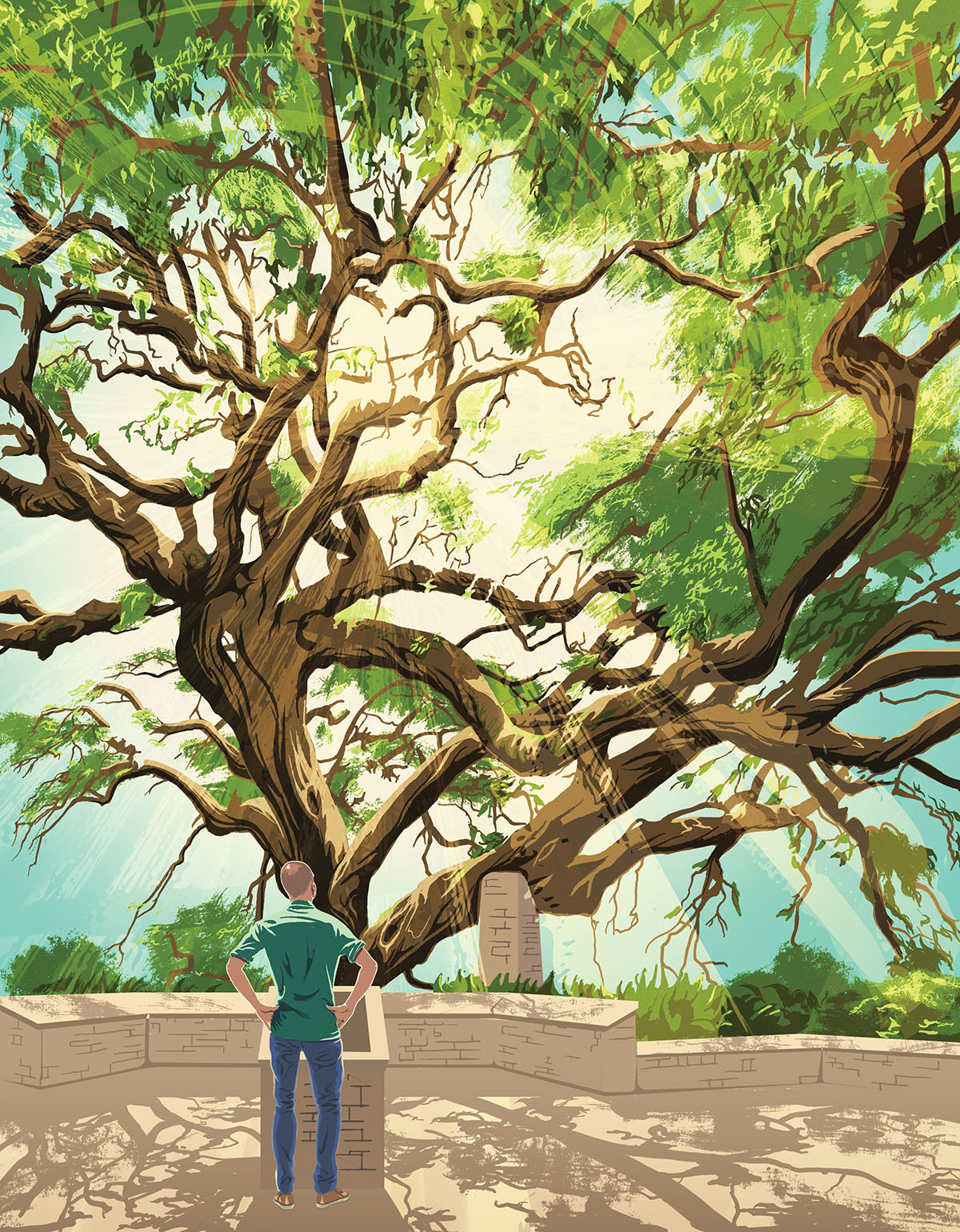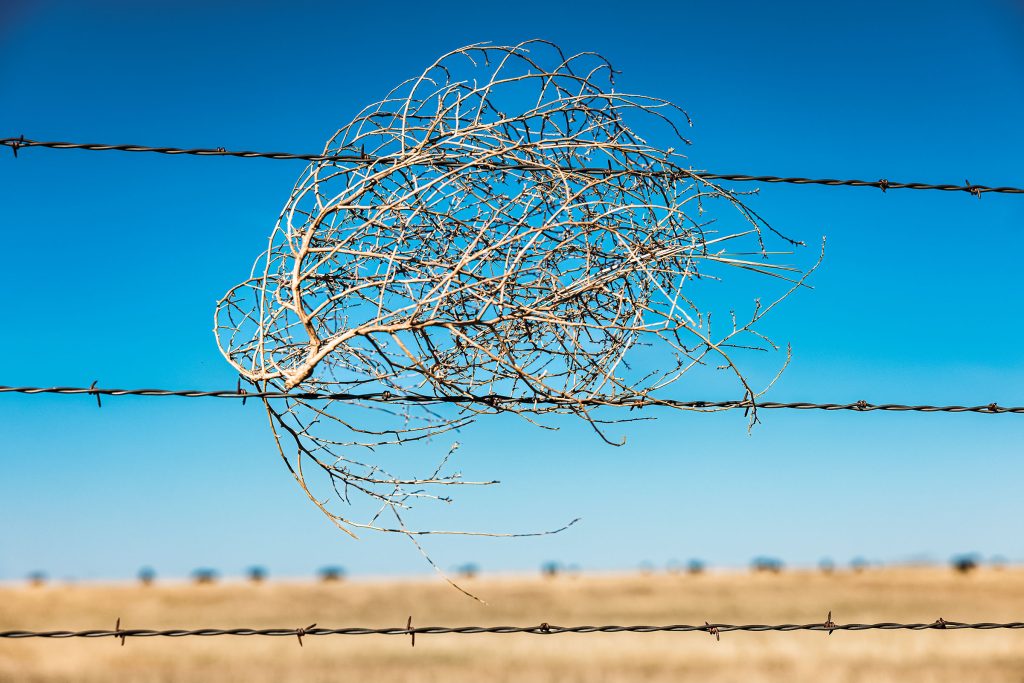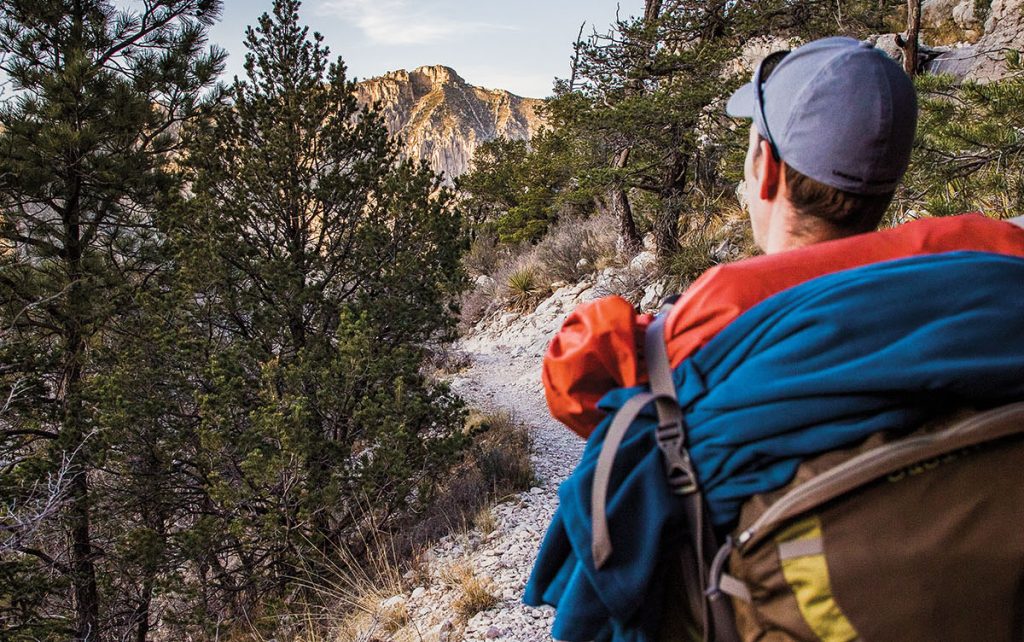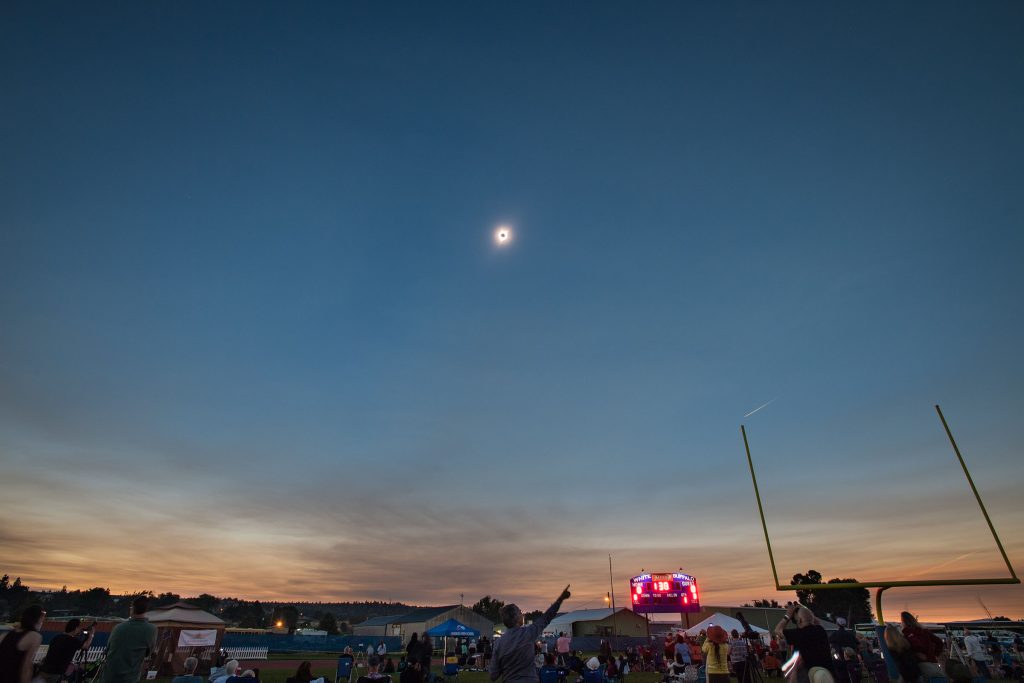
An Ancient Voice
A naturalist looks to Texas’ mighty oaks for serenity
By Lucas Loredo
It was the last fit of Texas winter. The oaks of the Lady Bird Johnson Wildflower Center, in Austin, had long since shed their waxy, emerald leaves, and their branches clacked in light wind. Phillip Schulze, the arboretum manager, piloted me on his golf cart through the center’s collection of all 53 oak species native to Texas, which boasts the greatest diversity of oak trees in the nation.
“Do this,” he said. “Take a room full of people, ask them to close their eyes and remember an important memory from their childhood. Then say, ‘Raise your hand if there was a tree present.’” We passed Spanish oak and lacey oak, bur oak and Chisos red. There were post oak and chinkapin. Shumard’s. Pin. “You watch,” he continued. “More than half, every time.” Then he tried it another way: “Ask kids, ‘Who likes to climb trees?’ All of them. It’s natural. Humans like trees. There’s a connection.”
Schulze wore a Lone Star State T-shirt overlaid with a chambray work top embroidered with the Wildflower Center logo and a ball cap with a neck cape. He nodded to the families we passed along the arboretum trail. Soon the path widened, opened up, and I got my first clear view of what I’d come to the Wildflower Center to see: the Hall of Texas Heroes.
You’d be forgiven if you imagined a row of stodgy historical photos hung along a dreary hallway. This display is nothing like that. Instead, a large circular clearing is populated by the offspring of some of Texas’ most storied oaks, those centenarian old-timers under whose shade treaties were signed, battles won and lost, romances set aflame. Now their 28 young children—all live oaks, one of Texas’ most enduring and hardy varieties—form concentric circles with a path around their circumference. Here, patrons can move under the still-budding shade of the youthful trees and read plaques about each of the 28 parents.
Schulze pulled the golf cart up alongside a succession of these plaques, telling me about his favorite trees in the collection. That’s when I felt a familiar sensation: complete and total panic. A clenching of anxiety. A sense of doom descending upon me. I held on to the cart’s grab handle and tried to focus on Schulze’s voice. He was telling me how the project started—his arborists gathered hundreds of acorns from the famous oaks and coaxed them to life in the nursery until the heartiest specimens could be separated from the rest and planted in the Hall of Texas Heroes. He said the Founders’ Oak in New Braunfels was his favorite for multiple reasons, not least of which is his pride in being a fifth-generation New Braunfelser. But I was finding it hard to concentrate.
I fancy myself an amateur tree enthusiast and have a laminated Central Texas tree identification pamphlet in my glove box. And yet, as much as I had come to the Hall of Texas Heroes to learn more about Texas’ most illustrious oaks, I had actually come here looking for something selfish. I was looking for peace.
At that point, I had been suffering from anxiety for 12 long months. A series of concurrent events had brought on this intense, unremitting feeling: the end of a five-year partnership akin to marriage, the failure of a three-year novel project, the end of graduate school, an unexpected move back to my parents’ house in Austin as a 29-year-old without a job.
This was part of the reason I was at the arboretum. Nature had always soothed me, and I thought being closer to some of Texas’ oldest and most serene trees might lend me some perspective. Some comfort.
The feeling hung around as Schulze drove me to the Wildflower Center’s nursery. Here, there were dozens of oak saplings in various stages of growth: one-year, three-year, and five-year trees. Some were an inch high and covered with wire mesh to protect them from squirrels, others tall enough to brush Schulze’s knees, and plenty my own height ready for planting.
One tree in a 5-gallon bucket caught my eye. On the container, written in white ink, was the name TREATY OAK. Austin’s Treaty Oak—where Stephen F. Austin is said to have signed the eponymous treaty with the Tonkawa and Comanche—has a truly unbelievable claim to fame. In 1989, a disgruntled man hoping to cast a love spell on his methadone counselor performed a ritual poisoning of the 600-year-old oak with enough hardwood herbicide to kill 100 trees. It took the effort of the nation’s top arborists—and a blank check from two-time presidential candidate Ross Perot—to save the tree from death. To see the offspring of that fabled oak was like meeting a local celebrity.
“I can’t believe you have one,” I said.
“I want to plant it at the center of the hall,” Schulze replied. “We’ll see if they let me.”
Schulze bent down and rooted around the base of the young oak and came up with three acorns in his hand. He placed them in my palm. “Feel that? See? Dense. No weevils got to them yet. Go home, plant them, see if they’ll grow.”
Nearing San Marcos, about 30 miles south of Austin, I passed Exxons and Shells advertising unleaded for a buck thirty-three, the lowest I’d seen since I was a boy. By then it was May, and the coronavirus had already hammered the nation and driven folks inside for safety. I’d made a list of eight trees from the Hall of Texas Heroes for a mini-tour of the original oaks in and near Austin, which seemed a fitting way to get back out into the world.
The Log Cabin Oaks and the Kissing Oak, both near the campus of Texas State University in San Marcos, were so close to each other they could’ve shared messages on the same wind. I parked in a strip mall—a large, empty lot, with stores either closed for good or boarded up for the time being—and checked my phone’s GPS to see if I was close to the Log Cabin Oaks. The Texas A&M Forest Service has a handy website that identifies and locates the state’s most hallowed trees, with exact coordinates down to the geographic minute. Following the blue marker on my phone’s screen, I came upon an oak with four close-knit trunks and a couple others standing watch nearby, their canopies all touching and root collars nearly suffocated by the lot’s pavement. These were the Log Cabin Oaks, where early settlers built a cabin that served as San Marcos’ first school and community center.
It was not an auspicious start to my tour. Near the oaks was a long-abandoned establishment whose sign read Colloquium Books. The ‘k’ was missing from the sign, and the handful of CRT televisions mounted from the ceiling tiles inside reminded me of a ’90s Blockbuster. Around the live oaks’ trunks, an assortment of Taco Bell hot sauce packets, mild, and two packs of Pall Mall Reds, empty. A blue jay picked through a smattering of used wet wipes and then flitted away.
I sat on the abandoned steps of Colloquium Books taking notes, listening to the cheerful quips of the jay nearby. And even here—calm, quiet, in the cover of shade—anxiety was with me.
For those who have never experienced persistent anxiety, please take a moment to imagine riding a roller coaster as it crawls to the top of its most thrilling drop. Up and up you climb, the people below, the buildings below, all shrinking to miniature. Then you are at the pinnacle. There is the moment the car hangs poised over the drop, an interminable anticipation, and then: Plunge! Scream! The absolute thrill of that first second as you go from safety to controlled terror, your stomach levitating inside, your senses confused, elated, terrorized.
Anxiety is that feeling of plunging and terror, but the trick is that the ride does not end. On a normal coaster, you can enjoy the thrill because you see where the track bends back up into safety. But this coaster doesn’t ever reach the bottom—it persists in plunging.
The problem for me was this: My anxiety did not seem triggered by external stimuli. It was internal. Biological. Constant. Like a switch inside had been flipped—then broken. If I couldn’t find peace while safely taking notes underneath a two-century-old oak, where could I find it?
I walked the two blocks from the Log Cabin Oaks down to the Kissing Oak. In 1857, Sam Houston, then a U.S. senator, gave an address underneath the large tree, and a few local women had hand stitched a Texas flag and presented Houston with it. After his speech, he gave them each a peck. Thus, the Kissing Oak.
The tree now stands at the edge of Sewell Park, which during the time of my visit was cordoned off with orange temporary fencing due to the pandemic. I sat on a limestone bench on the rim of the canopy’s shade. The trunk listed to the side, and one large, gnarled knuckle punched out from the bark. It was not an especially impressive tree. The Log Cabin Oaks weren’t either. I knew a dozen bigger, more impressive oaks off the top of my head in Austin alone.
Still, I listened, hoping the old-timer would have some words of wisdom. Because I hadn’t stopped riding that coaster. Nearby, a pecan—taller and more talkative with its papery leaves—spoke up. But if it had anything to tell me, I wasn’t smart enough to understand.
The following weekend, I traveled to New Braunfels—Schulze’s hometown—where I grabbed a donut and some coffee and made my way to the Church Oak, tucked up alongside Saints Peter and Paul Catholic Church. A stone tablet at the tree’s base, laid in 1917, tells a nice tale of mass being held under the tree’s boughs. That here, “in the dawn of Texas history, stood an Indian village in which one of the early missionaries lingered many days.” Texas historical landmarks tend to be light on details of how exactly such Native American villages met their ends.
The tree itself was an impressive corkscrewing of two large branches, evidence of the days when they were younger and nimbler in their search for light. Another branch stretched in the opposite direction so far it almost brushed the stained glass of the sanctuary. The thick bark flowed down in rivulets.
Sitting on the stone bench at the base of the Church Oak, I felt the familiar sensation in my stomach. I must stress this point: It’s not a single, discreet plunge, this roller-coaster ride of nervous illness. The descent lasts for one second, then 10. Then past 60 seconds. The sickening feeling continues, travels outward from my stomach. Five minutes stretch to 10. I cannot comprehend how it continues, but it does, and soon I have been plummeting down and down for an entire hour, an entire day, a full week, and that is when a sense of true fear enters. What if this never ends? What if it follows me wherever I go—forever?
I didn’t stay long. I fired up my hatchback and headed over to Landa Park, where I sought Schulze’s favorite hero from the collection: the Founders’ Oak. Following my GPS once again toward the tree, I had a few false starts, seeing a handful of likely specimens and wondering if I’d found it. But as soon as I saw the actual tree, there was no doubt. It made the other oaks in the vicinity look like mushrooms around a giant’s foot. Quercus fusiformis—never had a live oak earned the largesse of its Latinate designation quite like this. Of all the oaks I’ve admired in my life, the Founders’ Oak was the most impressive. Its girth was formidable; the trunk’s bark seemed to bubble with force, ready to sprout more limbs from its voluminous knuckles at any moment. The massive trunk split into three separate growths, two of which were undergirded by thick stone pillars, which the tree looked in the process of consuming. The branches were generous and unconcerned—lilting here, approaching the ground in a deep bend there. The physics of the whole enterprise was outlandish, making leaps of imagination, the intricate counterbalance of branches reaching clear out on the horizon with the weight of an elephant. The hulking mass put me in mind of an extinct land mammal.
It was the type of tree a child might flock to and then disappear inside of, leaving behind only the rippling folds of trunk and a single red shoe.
I found a bench underneath the generous canopy and pondered the tree a while. A nearby plaque dated the tree to 1700. So, 300-plus years of human life had passed under this same shade, had ruminated upon this same trunk, had heard these same branches channeling the wind’s voice. There were families on picnic blankets nearby, peals of laughter; ducks and birds—an alive place for a tree deep, deep into a lifespan few of us can comprehend.
I won’t bore the reader with the entire litany of actions I have taken to alleviate my illness, but here is a condensed version to keep in good faith: therapy, meditation, yoga, hikes in nature, medication, journaling, a rigorous sleep schedule, piano, gardening, herbal baths, burning sage, becoming a vegetarian, reaching out to family and friends.
Improvement, yes. Over the months, it’s true—improvement. But my nervous system remained burned out, frayed, on the fritz. You don’t know self-alienation until you’re kneeling in the dirt, sliding a spade into freshly tilled earth—a pittance of rosemary ready for planting—and then feeling yourself surge down that first terrifying drop of roller-coaster track.
Now? you think. Now, really? I’m gardening. It’s safe. Where’s the danger? Ain’t none, and that’s the rub. I listened to the Founders’ Oak a while, asked it a question. How do I be still inside? In response, the massive branches swayed in the breeze. The waxy leaves perked up and chattered their ancient language.
I visited a few more elder statespeople from the Hall of Texas Heroes over the next few weeks, moving quickly, my spirit restless. The Old Evergreen Tree in Giddings on the site of Rocking J Farming Services was an old, impressive oak with ferns growing on its muscular branches. There were three used tires and a rusted cattle hitch under the canopy, and when I made a walk of the trunk, something inside the trailer spooked—it wasn’t empty. Inside, a black-and-white pig gave me a look.
Back in Austin I visited the Seiders Oaks, within walking distance from my house along Shoal Creek Boulevard. A motte of trees, their fingers digging into the soil, and one of them bent from youth, likely by Native Americans, humbled next to the creek to mark the water’s presence.
The Battle Oaks were next, on the campus of the University of Texas. I sat quietly under the canopy. The bell of the striking clock in the UT Tower sounded the quarter hour. And still that restlessness inside, like I was a bug struggling to free my wing from under the thumb of some mean-spirited child.
A couple months later I visited the Treaty Oak in downtown Austin—the very same oak Schulze had given me acorns from six months prior. (The acorns had failed to sprout, and when I dug them up, I found tidy weevil holes puncturing their bottoms.)
It was June now, the air hot, a year and a half since the infinite plunge in my stomach had begun. These days I was feeling a bit better. Not whole, not cured, just better. I’d started listening to an audiobook called Hope and Help for Your Nerves, the main advice of which was to accept, accept, accept. Accept the plummeting inside. Do not fear it. Do not run away from it. Let it become a part of you. As it does, it will relinquish its grip.
I made a circle around the tree. Its growth was unusual. The trunk—not quite as massive as the Founders’ Oak’s, but plenty large—split in a large Y and reached up, up, only for the branches to fall from a soaring height straight downward. They’d long ago been weakened by poison and given in to gravity, reaching all the way down to the freshly cut grass and pooling at the ankles of the mother tree like corded rope. A field mouse spotted me and sprinted into a bush. The nurse tree—a smaller oak brought there by biologists to help the Treaty Oak return to health after it had fallen ill with poison—waited in the parent tree’s parlor, giving sustenance. Though it had been saved from death, it still bore the marks of its illness. An enormous portion of the canopy was missing, like a head of broccoli absent a chunk of its florets.
Accepting the plunge. Easier said than done. Still, it was another ingredient in the brew that was slowly nursing me back to health. The heroes had done their slow work on me, too, though not as quickly as I’d wanted. Old wisdom takes time to sink in. What wisdom was it? Being present. Simple as that—presence. A reminder of something I’d forgotten.
Sitting under the shade of the Treaty Oak, wondering what other offerings that massive tree might have for a speck like me, I drifted off to sleep.
In every wood, on the outskirts of every town, on each lonely hilltop, throughout time in every century since people existed, since before people existed and they spoke only to animals, and oftentimes to no one at all, every tree blowing in the wind has said the same sentence.
That’s the thought I had.
When I woke up, the wind passed through the branches of the Treaty Oak, and it spoke. Not an answer—an invitation.
Listen. Listen. Listen.








